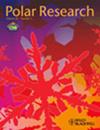挪威斯瓦尔巴群岛白鲸的生态和地位综述
IF 1.3
4区 地球科学
Q3 ECOLOGY
引用次数: 5
摘要
挪威极地研究所于1995年发起了一项关于白鲸的研究方案,以收集与该物种管理有关的生物资料;在此回顾其结果。1995年至2001年和2013年至2016年这两个时期(海冰显著减少)的卫星追踪显示,斯瓦尔巴群岛海域的鲸鱼大部分时间都在靠近潮汐冰川的地方觅食。冰川之间的过渡通常沿着海岸线,鲸鱼从一个冰川快速移动到另一个冰川。在后来的一段时间里,这些鲸鱼在峡湾里呆了一段时间,这表明它们可能是在大西洋水群中寻找猎物,而大西洋水群现在在斯瓦尔巴群岛西海岸的峡湾中盛行。他们的潜水深度大多极浅(13±26米;最长350米),持续时间短(97±123秒;最长31.4分钟)。脂肪酸分析表明,第一次取样期间,极地鳕鱼(Boreogadus saida)是主要猎物。2018年的一项航空调查估计,该种群有549只(CI: 436-723)。斯瓦尔巴白鲸与西格陵兰岛和白海的白鲸在基因上是不同的。虎鲸的捕食似乎影响了斯瓦尔巴群岛白鲸的行为;它们通常是沉默的,尽管它们有正常的声音,它们的海岸运动发生在非常浅的水域。这个人群的污染水平非常高。气候变化对这一小群白鲸构成了威胁。本文章由计算机程序翻译,如有差异,请以英文原文为准。
A review of the ecology and status of white whales (Delphinapterus leucas) in Svalbard, Norway
The Norwegian Polar Institute initiated a research programme on white whales in 1995 to gather biological information relevant for the species’ management; the results of which are reviewed herein. Satellite tracking from two periods (1995–2001 and 2013–16), between which sea ice diminished markedly, showed that the whales in waters off the archipelago of Svalbard spent most of their time foraging close to tidewater glaciers. Transits between glaciers typically followed the coastline, with the whales moving rapidly from one glacier to another. During the later period, the whales spent some time out in the fjords, suggesting that they might be targeting prey in the Atlantic Water masses that now prevail in Svalbard’s west-coast fjords. Most of their dives were extremely shallow (13 ± 26 m; maximum 350 m) and of short duration (97 ± 123 s; maximum 31.4 min). Fatty-acid analyses indicated that polar cod (Boreogadus saida) was the main prey during the first sampling period. An aerial survey in 2018 estimated the population numbered 549 (CI: 436–723) animals. Svalbard white whales are genetically separate from populations off west Greenland and in the White Sea. Predation by killer whales appears to have influenced white whale behaviour in Svalbard; they are often silent, despite having a normal vocal repertoire for the species and their coastal movements take place in very shallow water. This population has extremely high contaminant levels. Climate change poses a threat to this small population of white whales.
求助全文
通过发布文献求助,成功后即可免费获取论文全文。
去求助
来源期刊

Polar Research
地学-地球科学综合
CiteScore
3.20
自引率
5.30%
发文量
22
审稿时长
>12 weeks
期刊介绍:
Since 1982, Polar Research has been the international, peer-reviewed journal of the Norwegian Polar Institute, Norway''s central institution for research, environmental monitoring and mapping of the polar regions. Aiming to promote the exchange of scientific knowledge about the Arctic and Antarctic across disciplinary boundaries, Polar Research serves an international community of researchers and managers. As an open-access journal, Polar Research makes its contents freely available to the general public.
Original primary research papers comprise the mainstay of Polar Research. Review articles, brief research notes, letters to the editor and book reviews are also included. Special issues are published from time to time.
The scope of Polar Research encompasses research in all scientific disciplines relevant to the polar regions. These include, but are not limited to, the subfields of biology, ecology, geology, oceanography, glaciology and atmospheric science. Submissions from the social sciences and those focusing on polar management and policy issues are welcome. Contributions about Antarctica are particularly encouraged.
 求助内容:
求助内容: 应助结果提醒方式:
应助结果提醒方式:


